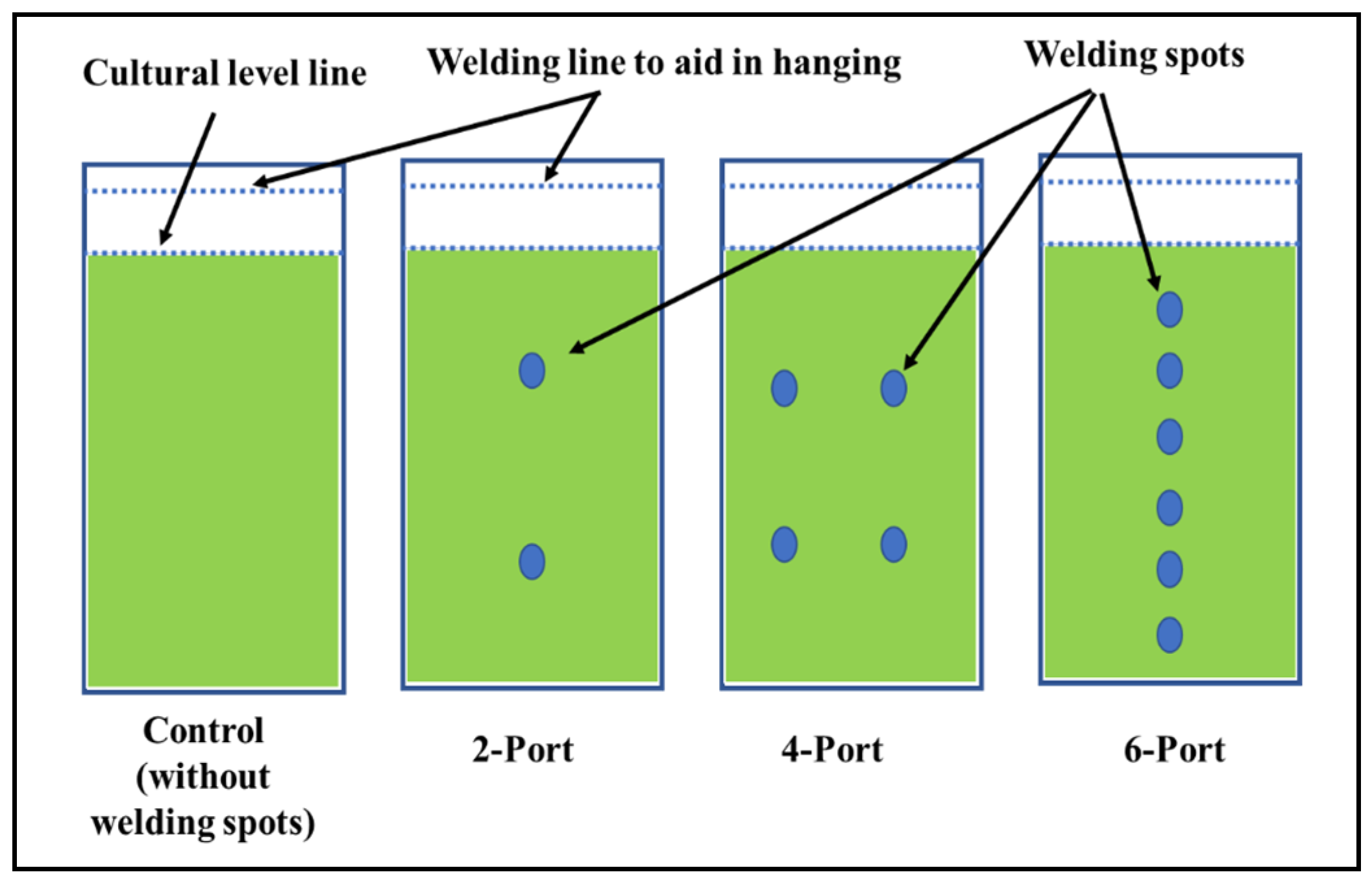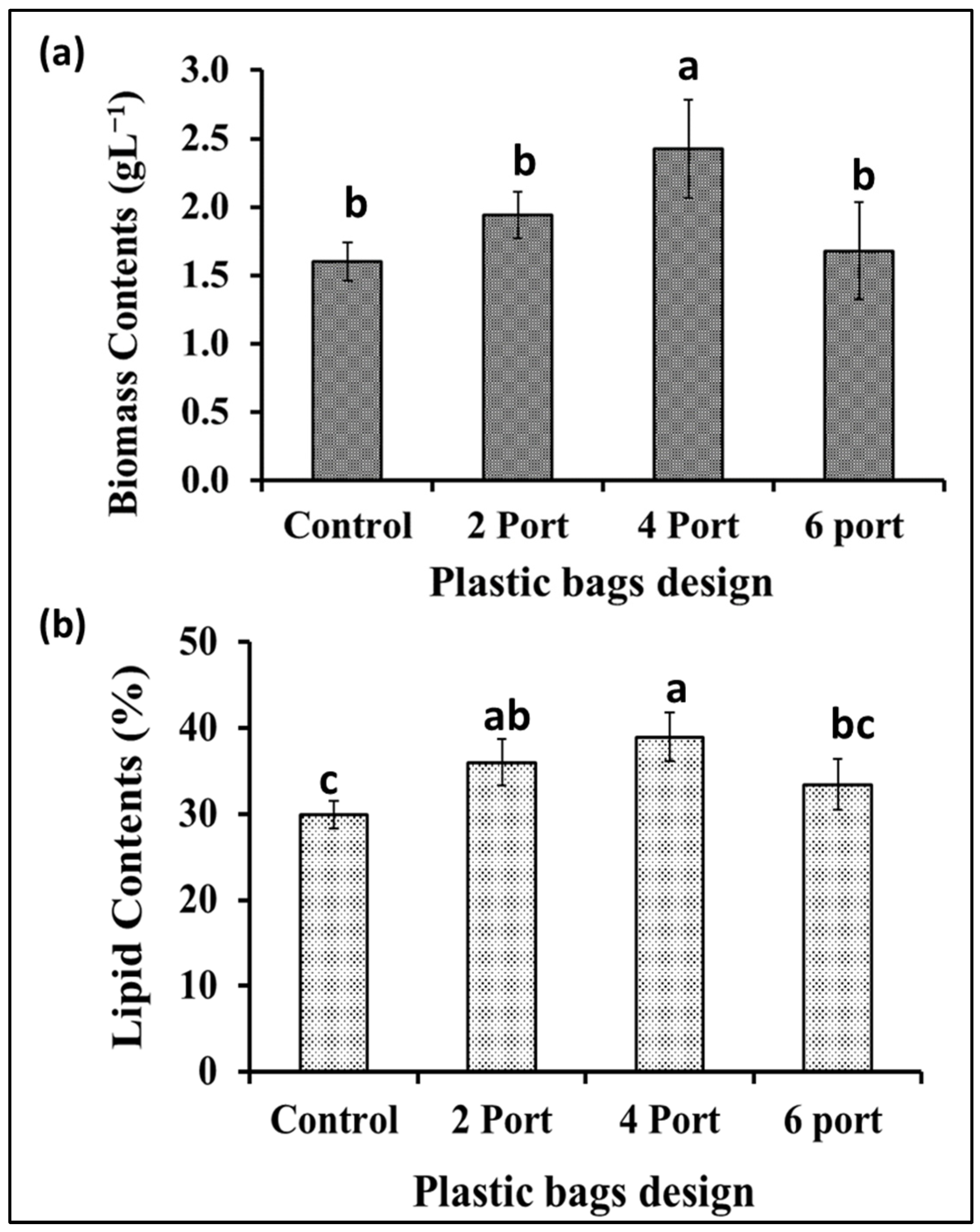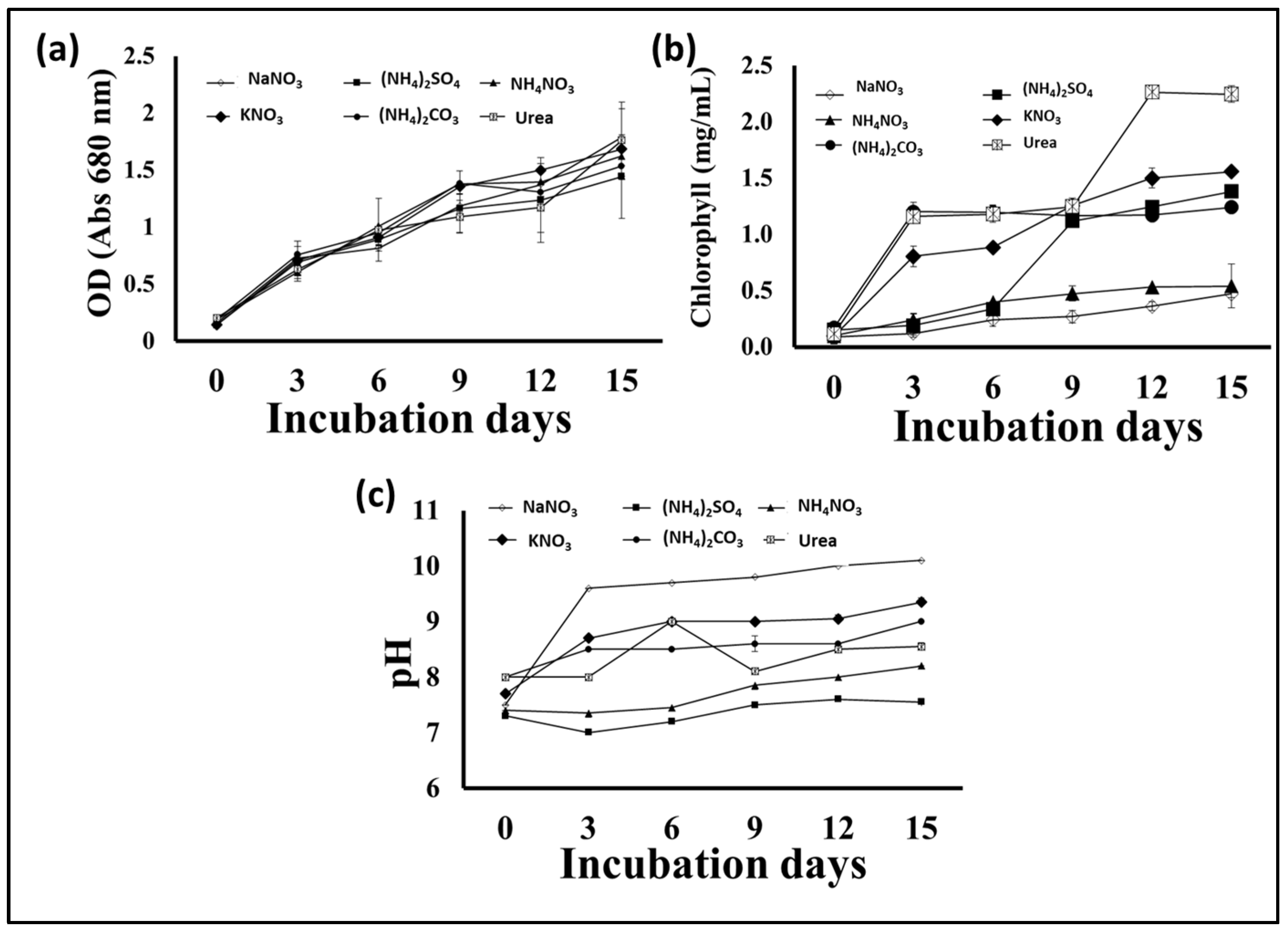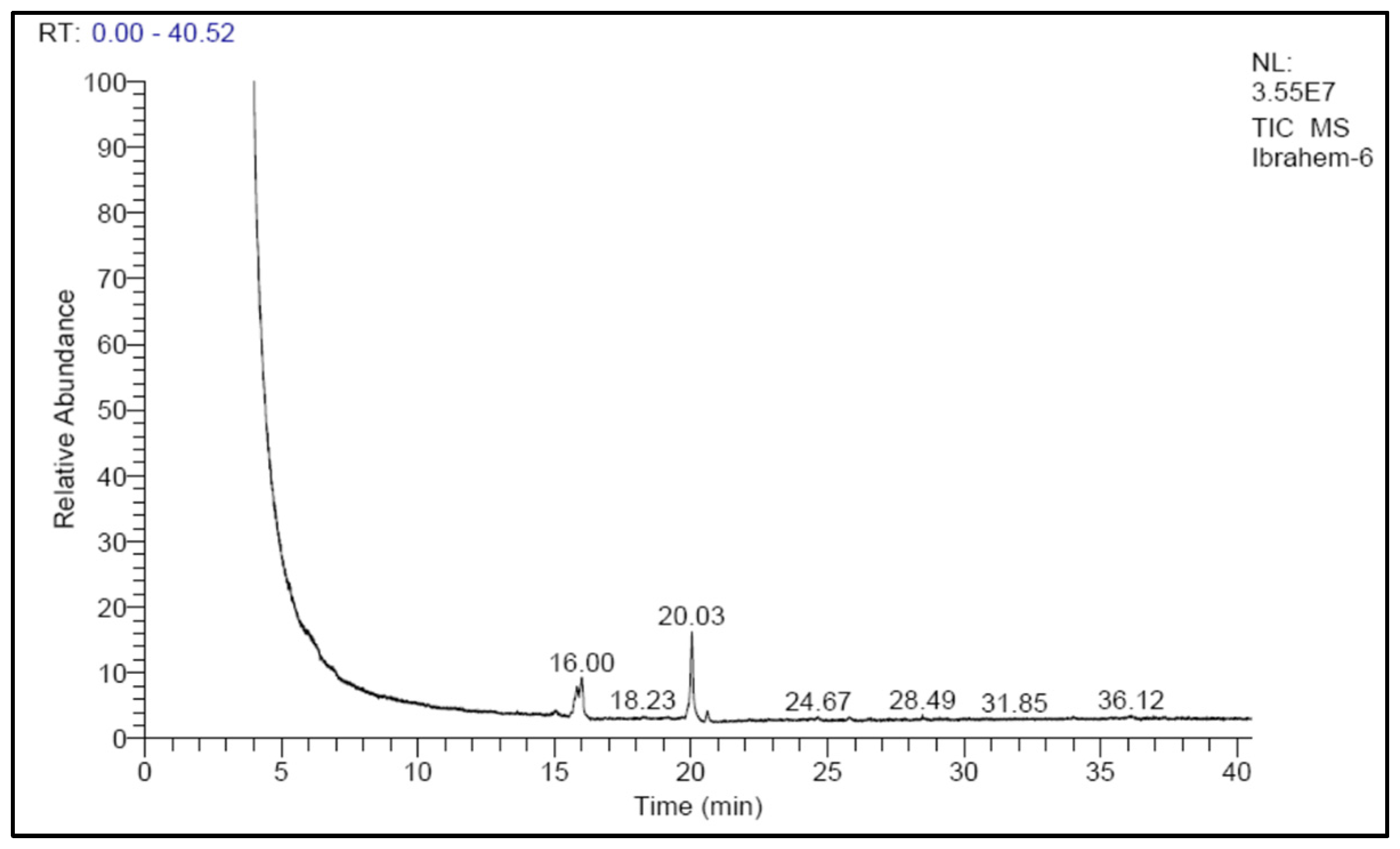Enhanced Scenedesmus obliquus Cultivation in Plastic-Type Flat Panel Photobioreactor for Biodiesel Production
Abstract
1. Introduction
2. Materials and Methods
2.1. Microalgal Strain and Growth Medium
2.2. Growth Parameters
2.2.1. Optical Density
2.2.2. Chlorophyll Content
2.2.3. Biomass Production
2.3. Lipid Contents
2.4. GC Characterization of Lipid Profile for Microalgae Samples
2.5. Materials and Design of Used Cultivation Systems
2.5.1. Glass Tanks as Flat-Panel Photobioreactor (FPP)
2.5.2. Plastic Bags as Flat Panel Photobioreactors (FPPs)
2.5.3. 6 L Plastic Bottles
2.6. Optimization of Cultivation Conditions
2.6.1. Types of Photobioreactors Materials
2.6.2. Thickness of Plastic Sheets as FPP
2.6.3. Plastic Bags Design
2.6.4. Nitrogen Source
2.6.5. Light Intensity
2.6.6. Optimization of Air Flow
2.7. Biodiesel Production
2.8. Statistical Analysis
3. Results and Discussion
3.1. Screening Different Cultivation Containers for Microalgal Growth
3.2. Optimization of Plastic Bag Design on Microalgal Growth
3.3. Optimization of N-Source
3.4. Optimization of Light Intensity
3.5. Optimization of Air Flow
3.6. Biodiesel Production from S. obliquus under Optimized Conditions
4. Conclusions
Author Contributions
Funding
Institutional Review Board Statement
Informed Consent Statement
Data Availability Statement
Acknowledgments
Conflicts of Interest
References
- Abomohra, A.E.F.; El-Sheekh, M.; Hanelt, D. Pilot cultivation of the chlorophyte microalga Scenedesmus obliquus as a promising feedstock for biofuel. Biomass Bioenergy 2014, 64, 237–244. [Google Scholar] [CrossRef]
- Bisht, T.S.; Pandey, M.; Pande, V. Impact of different nitrogen sources on biomass growth and lipid productivity of Scenedesmus sp. for biodiesel production. J. Algal Biomass Utln. 2016, 7, 8–36. [Google Scholar]
- Ayad, H.I.; Matter, I.A.; Gharieb, M.M.; Darwesh, O.M. Bioflocculation harvesting of oleaginous microalga Chlorella sp. using novel lipid-rich cellulolytic fungus Aspergillus terreus (MD1) for biodiesel production. Biomass Convers. Biorefin. 2023, 1–13. [Google Scholar] [CrossRef]
- Matter, I.A.; Bui, V.K.H.; Jung, M.; Seo, J.Y.; Kim, Y.E.; Lee, Y.C.; Oh, Y.K. Flocculation harvesting techniques for microalgae: A review. Appl. Sci. 2019, 9, 3069. [Google Scholar] [CrossRef]
- Amaral, M.S.; Loures, C.C.; Naves, F.L.; Samanamud, G.L.; Silva, M.B.; Prata, A.M. Microalgae cultivation in photobioreactors aiming at biodiesel production. In Biotechnological Applications of Biomass; Peixoto Basso, T., Olitta Basso, T., Carlos Basso, L., Eds.; IntechOpen: London, UK, 2021. [Google Scholar] [CrossRef]
- Chen, Y.P.; Huang, Y.H.; Huang, H.C. Different plastic-bag type photobioreactor for biomass production of Chlorella species. In Proceedings of the IOP Conference Series: Materials Science and Engineering, Johor, Malaysia, 16–17 January 2021; IOP Publishing: Bristol, UK, 2021; Volume 1113, p. 012004. [Google Scholar]
- Chen, C.Y.; Chang, J.S.; Chang, H.Y.; Chen, T.Y.; Wu, J.H.; Lee, W.L. Enhancing microalgal oil/lipid production from Chlorella sorokiniana CY1 using deep-sea water supplemented cultivation medium. Biochem. Eng. J. 2013, 77, 74–81. [Google Scholar] [CrossRef]
- Chowdury, K.H.; Nurun, N.; Deb, U.K. The growth factors involved in microalgae cultivation for biofuel production: A review. Comput. Water Eng. Environ. Eng. 2020, 9, 185–215. [Google Scholar] [CrossRef]
- Ahmad, I.; Abdullah, N.; Koji, I.; Yuzir, A.; Muhammad, S.E. Evolution of photobioreactors: A review based on microalgal perspective. In Proceedings of the IOP Conference Series: Materials Science and Engineering, Johor, Malaysia, 16–17 January 2021; IOP Publishing: Bristol, UK, 2021; Volume 1142, p. 012004. [Google Scholar]
- Hijazi, R.; Mounsef, J.R.; Kanaan, H.Y. Design considerations for photo-bioreactors: A review. In Proceedings of the 2020 5th International Conference on Renewable Energies for Developing Countries (REDEC), Marrakech, Morocco, 29–30 June 2020; IEEE: Piscataway, NJ, USA, 2020; pp. 1–7. [Google Scholar] [CrossRef]
- Ravishankar, G.A.; Ambati, R.R. (Eds.) Handbook of Algal Technologies and Phytochemicals: Phycoremediation, Biofuels and Global Biomass Production; CRC Press: Boca Raton, FL, USA, 2019; Volume 2. [Google Scholar] [CrossRef]
- Al-Dailami, A.; Koji, I.; Ahmad, I.; Goto, M. Potential of photobioreactors (PBRs) in cultivation of microalgae. J. Adv. Res. Appl. Sci. Eng. Technol. 2022, 27, 32–44. [Google Scholar] [CrossRef]
- Uyar, B.; Ali, M.D.; Uyar, G.E.O. Design parameters comparison of bubble column, airlift and stirred tank photobioreactors for microalgae production. Bioprocess Biosyst. Eng. 2024, 47, 195–209. [Google Scholar] [CrossRef]
- Hirayama, A.; Sueyoshi, M.N.; Nakano, T.; Ota, Y.; Kurita, H.; Tasaki, M.; Kuroiwa, Y.; Kato, T.; Serizawa, S.; Kojima, K.; et al. Development of large-scale microalgae production in the Middle East. Bioresour. Technol. 2022, 343, 126036. [Google Scholar] [CrossRef] [PubMed]
- Sevda, S.; Bhattacharya, S.; Reesh, I.M.A.; Bhuvanesh, S.; Sreekrishnan, T.R. Challenges in the design and operation of an efficient photobioreactor for microalgae cultivation and hydrogen production. In Biohydrogen Production: Sustainability of Current Technology and Future Perspective; Singh, A., Rathore, D., Eds.; Springer: New Delhi, India, 2017; pp. 147–162. [Google Scholar] [CrossRef]
- Ihsan, E.K.İ.N. Types of microalgae cultivation photobioreactors and production process of microalgal biodiesel as alternative fuel. Acta Biol. Turc. 2020, 33, 114–131. [Google Scholar]
- Wang, X.; Zhou, Y.; Peng, Q.; Han, Y.; Yang, J.; Xu, H.; Li, C.; Li, L.; Dou, S.; Yang, M.; et al. Development of plastic flatbed-based algal culture system deployable on non-arable land. Algal Res. 2022, 66, 102814. [Google Scholar] [CrossRef]
- Singh, G.; Patidar, S.K. Microalgae harvesting techniques: A review. J. Environ. Manag. 2018, 217, 499–508. [Google Scholar] [CrossRef] [PubMed]
- Khoo, K.S.; Ahmad, I.; Chew, K.W.; Iwamoto, K.; Bhatnagar, A.; Show, P.L. Enhanced microalgal lipid production for biofuel using different strategies including genetic modification of microalgae: A review. Prog. Energy Combust. Sci. 2023, 96, 101071. [Google Scholar] [CrossRef]
- Sero, E.T.; Siziba, N.; Bunhu, T.; Shoko, R.; Jonathan, E. Biophotonics for improving algal photobioreactor performance: A review. Int. J. Energy Res. 2020, 44, 5071–5092. [Google Scholar] [CrossRef]
- Płaczek, M.; Patyna, A.; Witczak, S. Technical evaluation of photobioreactors for microalgae cultivation. E3S Web Conf. 2017, 19, 02032. [Google Scholar] [CrossRef]
- Norsker, N.H.; Cuaresma, M.; de Vree, J.; Ruiz-Domínguez, M.C.; García, M.C.M.; Uronen, P.; Barbosa, M.J.; Wijffels, R. Neochloris oleoabundans oil production in an outdoor tubular photobioreactor at pilot scale. J. Appl. Phycol. 2021, 33, 1327–1339. [Google Scholar] [CrossRef]
- Eida, M.F.; Darwesh, O.M.; Matter, I.A. Cultivation of oleaginous microalgae Scenedesmus obliquus on secondary treated municipal wastewater as growth medium for biodiesel production. J. Ecol. Eng. 2018, 19, 38–51. [Google Scholar] [CrossRef]
- Wang, Y.; Wang, J.; Wang, T.; Wang, C. Simultaneous detection of viability and concentration of microalgae cells based on chlorophyll fluorescence and bright field dual imaging. Micromachines 2021, 12, 896. [Google Scholar] [CrossRef]
- de Freitas, C.; Carmona, E.; Brienzo, M. Xylooligosaccharides production process from lignocellulosic biomass and bioactive effects. Bioact. Carbohydr. Diet. 2019, 18, 100184. [Google Scholar] [CrossRef]
- Ichihara, K.I.; Fukubayashi, Y. Preparation of fatty acid methyl esters for gas-liquid chromatography [S]. J. Lipid Res. 2010, 51, 635–640. [Google Scholar] [CrossRef]
- Carvalho, A.P.; Monteiro, C.M.; Malcata, F.X. Simultaneous effect of irradiance and temperature on biochemical composition of the microalga Pavlova lutheri. J. Appl. Phycol. 2009, 21, 543–552. [Google Scholar] [CrossRef]
- Benner, P.; Meier, L.; Pfeffer, A.; Krüger, K.; Oropeza Vargas, J.E.; Weuster-Botz, D. Lab-scale photobioreactor systems: Principles, applications, and scalability. Bioprocess Biosyst. Eng. 2022, 45, 791–813. [Google Scholar] [CrossRef] [PubMed]
- Huang, Q.; Jiang, F.; Wang, L.; Yang, C. Design of photobioreactors for mass cultivation of photosynthetic organisms. Engineering 2017, 3, 318–329. [Google Scholar] [CrossRef]
- Sirohi, P.; Verma, H.; Singh, S.K.; Singh, V.K.; Pandey, J.; Khusharia, S.; Kumar, D.; Kaushalendra; Teotia, P.; Kumar, A. Microalgal carotenoids: Therapeutic application and latest approaches to enhance the production. Curr. Issues Mol. Biol. 2022, 44, 6257–6279. [Google Scholar] [CrossRef]
- Pahlavanyali, M.; Jalili, H.; Noroozi, M.; Morady, Y.; Hallajisani, A. The effect of temperature and different carbon and nitrogen sources on the growth and fatty acid profile of a newly isolated microorganism Aurantiochytrium sp. strain SHY. Iran. J. Fish. Sci. 2020, 19, 3112–3126. [Google Scholar]
- Chi, Y.; Chen, F.; Takiguchi, Y. Effect of nitrogen source on biomass and lipid production of a marine microalga, Nannochloropsis oceanica IMET1. Green Sustain. Chem. 2015, 5, 101. [Google Scholar] [CrossRef]
- Kim, D.Y.; Vijayan, D.; Praveenkumar, R.; Han, J.I.; Lee, K.; Park, J.Y.; Chang, W.S.; Lee, J.S.; Oh, Y.K. Cell-wall disruption and lipid/astaxanthin extraction from microalgae: Chlorella and Haematococcus. Bioresour. Technol. 2016, 199, 300–310. [Google Scholar] [CrossRef] [PubMed]
- Lin, Q.; Lin, J. Effects of nitrogen source and concentration on biomass and oil production of a Scenedesmus rubescens like microalga. Bioresour. Technol. 2011, 102, 1615–1621. [Google Scholar] [CrossRef]
- Amin, N.F.; Khalafallah, M.A.; Ali, M.A.; Abou-Sdera, S.A.; Matter, I.A. Effect of some nitrogen sources on growth and lipid of microalgae Chlorella sp. for biodiesel production. J. Appl. Sci. Res. 2013, 9, 4845–4855. [Google Scholar]
- Darwesh, O.M.; Matter, I.A.; Eida, M.F.; Moawad, H.; Oh, Y.K. Influence of nitrogen source and growth phase on extracellular biosynthesis of silver nanoparticles using cultural filtrates of Scenedesmus obliquus. Appl. Sci. 2019, 9, 1465. [Google Scholar] [CrossRef]
- Dhup, S.; Kannan, D.C.; Dhawan, V. Understanding urea assimilation and its effect on lipid production and fatty acid composition of Scenedesmus sp. SOJ Biochem. 2016, 2, 1–7. [Google Scholar] [CrossRef]
- Chhandama, M.V.L.; Ruatpuia, J.V.; Ao, S.; Chetia, A.C.; Satyan, K.B.; Rokhum, S.L. Microalgae as a sustainable feedstock for biodiesel and other production industries: Prospects and challenges. Energy Nexus 2023, 12, 100255. [Google Scholar] [CrossRef]
- Krausfeldt, L.E.; Farmer, A.T.; Castro Gonzalez, H.F.; Zepernick, B.N.; Campagna, S.R.; Wilhelm, S.W. Urea is both a carbon and nitrogen source for Microcystis aeruginosa: Tracking 13C incorporation at bloom pH conditions. Front. Microbiol. 2019, 10, 1064. [Google Scholar] [CrossRef] [PubMed]
- Kuo, H.T.; Zhang, Z.; Zhang, C.; Merkens, H.; Tan, R.; Wong, A.A.; Uribe, C.F.; Bénard, F.; Lin, K.S. Lys-urea-Aad, Lys-urea-Cmc and Lys-urea-Cms as potential pharmacophores for the design of PSMA-targeted radioligands to reduce off-target uptake in kidneys and salivary glands. Theranostics 2023, 13, 4559. [Google Scholar] [CrossRef] [PubMed]
- Gao, P.; Guo, L.; Gao, M.; Zhao, Y.; Jin, C.; She, Z. Regulation of carbon source metabolism in mixotrophic microalgae cultivation in response to light intensity variation. J. Environ. Manag. 2022, 302, 114095. [Google Scholar] [CrossRef] [PubMed]
- Maltsev, Y.; Maltseva, K.; Kulikovskiy, M.; Maltseva, S. Influence of light conditions on microalgae growth and content of lipids, carotenoids, and fatty acid composition. Biology 2021, 10, 1060. [Google Scholar] [CrossRef]
- Nzayisenga, J.C.; Farge, X.; Groll, S.L.; Sellstedt, A. Effects of light intensity on growth and lipid production in microalgae grown in wastewater. Biotechnol. Biofuels 2020, 13, 4. [Google Scholar] [CrossRef] [PubMed]
- Vélez-Landa, L.; Hernández-De León, H.R.; Pérez-Luna, Y.D.C.; Velázquez-Trujillo, S.; Moreira-Acosta, J.; Berrones-Hernández, R.; Sánchez-Roque, Y. Influence of light intensity and photoperiod on the photoautotrophic growth and lipid content of the microalgae Verrucodesmus verrucosus in a photobioreactor. Sustainability 2021, 13, 6606. [Google Scholar] [CrossRef]
- Kumar, M.; Kulshreshtha, J.; Singh, G.P. Growth and biopigment accumulation of cyanobacterium Spirulina platensis at different light intensities and temperature. Braz. J. Microbiol. 2011, 42, 1128–1135. [Google Scholar] [CrossRef]
- Zhu, S.; Huang, W.; Xu, J.; Wang, Z.; Xu, J.; Yuan, Z. Metabolic changes of starch and lipid triggered by nitrogen starvation in the microalga Chlorella zofingiensis. Bioresour. Technol. 2014, 152, 292–298. [Google Scholar] [CrossRef]
- Han, W.; Jin, W.; Ding, W.; Lu, S.; Song, K.; Chen, C.; Qin, C.; Chen, Y.; Tu, R.; Zhou, X. Effects of nutrient composition, lighting conditions, and metal ions on the growth and lipid yield of the high-lipid-yielding microalgae (Chlorella pyrenoidosa) cultivated in municipal wastewater. J. Environ. Chem. Eng. 2021, 9, 106491. [Google Scholar] [CrossRef]
- Kazbar, A.; Cogne, G.; Urbain, B.; Marec, H.; Le-Gouic, B.; Tallec, J.; Takache, H.; Ismail, A.; Pruvost, J. Effect of dissolved oxygen concentration on microalgal culture in photobioreactors. Algal Res. 2014, 39, 101432. [Google Scholar] [CrossRef]
- Chanquia, S.N.; Vernet, G.; Kara, S. Photobioreactors for cultivation and synthesis: Specifications, challenges, and perspectives. Eng. Life Sci. 2022, 22, 712–724. [Google Scholar] [CrossRef]
- Amzah, N.F.; Mohamad, S.E.B.; Akhir, F.N.M.; Othman, F.S.; Suzuki, I.; Maeda, Y. Effect of agitation on growth and fatty acid composition of green microalgae Acutodesmus obliquus Q2-12E. Chem. Eng. Trans. 2023, 106, 1231–1236. [Google Scholar] [CrossRef]
- Thanh, N.T.; Uemura, Y.; Krishnan, V.; Ismail, L. The effect of air injection rate and medium nitrogen concentration on cell biomass and lipid content of Scenedesmus quadricauda in flat plate photobioreactor. Procedia Eng. 2016, 148, 538–545. [Google Scholar] [CrossRef]
- Thanh, N.T.; Uemura, Y.; Osman, N.; Ismail, L. The effect of aeration rate on the growth of Scenedesmus quadricauda in column photobioreactor. J. Jpn. Inst. Energy 2015, 94, 177–180. [Google Scholar] [CrossRef][Green Version]
- Touliabah, H.E.; Abdel-Hamid, M.I.; Almutairi, A.W. Long-term monitoring of the biomass and production of lipids by Nitzschia palea for biodiesel production. Saudi J. Biol. Sci. 2020, 27, 2038–2046. [Google Scholar] [CrossRef]
- Branco-Vieira, M.; Mata, T.M.; Martins, A.A.; Freitas, M.A.V.; Caetano, N.S. Economic analysis of microalgae biodiesel production in a small-scale facility. Energy Rep. 2020, 6, 325–332. [Google Scholar] [CrossRef]












| Fatty Acid | Carbon Chain/Saturation | % of Defined Fatty Acids | Notes |
|---|---|---|---|
| Palmitic acid | C16:0 | 23.9 | Saturated |
| Palmitoleic acid | C16:1 | 56.0 | Unsaturated |
| Oleic acid | C18:1 | 7.5 | Unsaturated |
| Linolenic acid | C18:3 | 3.1 | Unsaturated |
| Other fatty acids | <C16 or >C18 | 9.5 | ND |
Disclaimer/Publisher’s Note: The statements, opinions and data contained in all publications are solely those of the individual author(s) and contributor(s) and not of MDPI and/or the editor(s). MDPI and/or the editor(s) disclaim responsibility for any injury to people or property resulting from any ideas, methods, instructions or products referred to in the content. |
© 2024 by the authors. Licensee MDPI, Basel, Switzerland. This article is an open access article distributed under the terms and conditions of the Creative Commons Attribution (CC BY) license (https://creativecommons.org/licenses/by/4.0/).
Share and Cite
Abdel-Baset, A.; Matter, I.A.; Ali, M.A. Enhanced Scenedesmus obliquus Cultivation in Plastic-Type Flat Panel Photobioreactor for Biodiesel Production. Sustainability 2024, 16, 3148. https://doi.org/10.3390/su16083148
Abdel-Baset A, Matter IA, Ali MA. Enhanced Scenedesmus obliquus Cultivation in Plastic-Type Flat Panel Photobioreactor for Biodiesel Production. Sustainability. 2024; 16(8):3148. https://doi.org/10.3390/su16083148
Chicago/Turabian StyleAbdel-Baset, Amira, Ibrahim A. Matter, and Mohamed A. Ali. 2024. "Enhanced Scenedesmus obliquus Cultivation in Plastic-Type Flat Panel Photobioreactor for Biodiesel Production" Sustainability 16, no. 8: 3148. https://doi.org/10.3390/su16083148
APA StyleAbdel-Baset, A., Matter, I. A., & Ali, M. A. (2024). Enhanced Scenedesmus obliquus Cultivation in Plastic-Type Flat Panel Photobioreactor for Biodiesel Production. Sustainability, 16(8), 3148. https://doi.org/10.3390/su16083148







